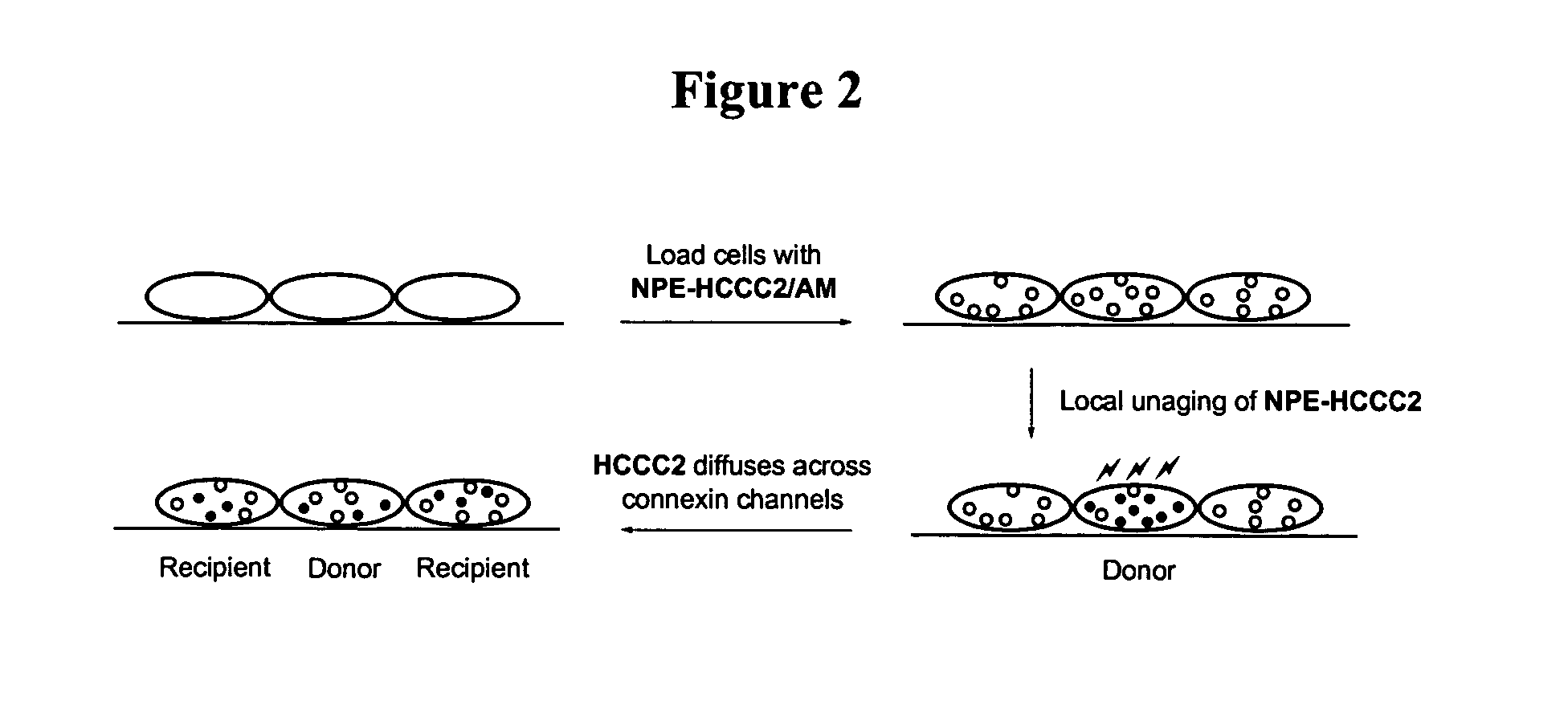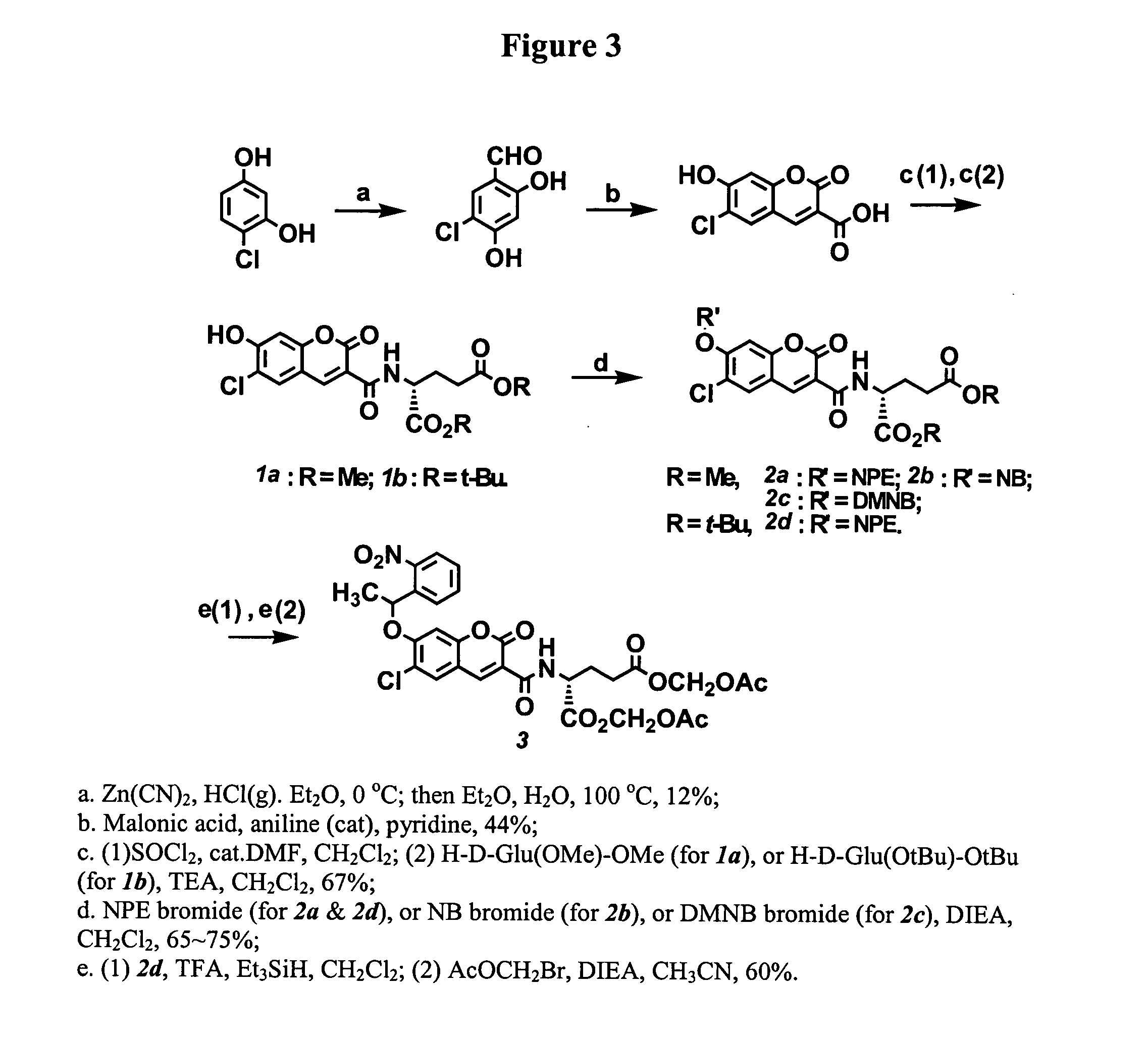Photo-caged fluorescent molecules
a fluorescent molecule and photocage technology, applied in the field of fluorescent molecules, can solve the problems of cell membrane damage, method is associated with a number of major limitations, and molecules are not ideally suited for use as photocaged fluorescent molecules
- Summary
- Abstract
- Description
- Claims
- Application Information
AI Technical Summary
Benefits of technology
Problems solved by technology
Method used
Image
Examples
example 1
General Synthesis
6-Chloro-7-hydroxy-coumarin 3-carboxylate was prepared in two steps starting with 4-chloro-resorcinol. Coupling coumarin 3-carboxylate with the methyl ester of D-glutamate provided coumarin 3-carboxamide (1a, FIG. 3). The dye absorbs maximally at 408 nm with an extinction coefficient of 44,000. The fluorescent quantum yield of the molecule is 0.93 measured in an aqueous buffer (100 mM KCl, 20 mM Mops, pH 7.35). Three caged derivatives of this fluorophore were synthesized by masking the 7-hydroxyl group of coumarin with the following caging groups: 1-(2-nitrophenyl)ethyl (“NPE,” 2a, FIG. 3), 2-nitrobenzyl (“NB,” 2b, FIG. 3), and 4,5-dimethoxy-2-nitrobenzyl (“DMNB,” 2c, FIG. 3).
example 2
Photoactivation and Excitation
The three caged coumarins prepared in Example 1 (2a, 2b, 2c, FIG. 3) were dissolved in aqueous buffer (pH 7.35) containing 100 mM KCl and 20 mM Mops to final concentrations of 2 μM. The solutions were photolyzed with 365 nm light from a filtered mercury lamp. Fluorescence emission spectra at 408 nm of the solutions were taken with a Fluorolog spectrometer (Jobin-Yvon) after different UV exposures. FIG. 4 shows the spectra of NPE-caged coumarin (2a, FIG. 3).
All three caged fluorophores prepared in Example 1 are essentially non-fluorescent, as shown by their negligible fluorescence quantum yields in Table 2 below. UV illumination (365 nm) removed the caging group and progressively generated highly fluorescent coumarin 1a, as shown in FIG. 5. The fluorescence enhancements after uncaging ranged from 200 times (2b) to nearly 800 times (2c). This robust change in fluorescence quantum yields is important for generating high contrast optical signals with a ...
example 3
Esterification
Protection of the two carboxylates of the D-glutamate moiety with acetoxymethyl (“AM”) ester groups is useful for cellular imaging applications. AM esters are stable in physiological solutions but are susceptible to enzymatic hydrolysis by cellular esterases. The enzyme hydrolysis regenerates negatively charged species which cannot diffuise out of cells (Grynkiewicz, et al., 1985). This irreversible trapping process has been applied to enrich various ion indicators, fluorescent probes, and second messengers into cells to higher concentrations (Li, et al., 1998). With the current caged coumarin derivatives, hydrolysis of two methyl esters of compound 2a under a number of conditions was accompanied by the concomitant hydrolysis of the amide bond of coumarin 3-carboaximide. Thus, protecting two carboxylates of glutamate with t-butyl groups is a more feasible synthetic route. Acid treatments of the intermediate 2d (prepared from 1b, FIG. 3) followed by esterification wit...
PUM
| Property | Measurement | Unit |
|---|---|---|
| wavelengths | aaaaa | aaaaa |
| non-fluorescent | aaaaa | aaaaa |
| fluorescence | aaaaa | aaaaa |
Abstract
Description
Claims
Application Information
 Login to View More
Login to View More - R&D
- Intellectual Property
- Life Sciences
- Materials
- Tech Scout
- Unparalleled Data Quality
- Higher Quality Content
- 60% Fewer Hallucinations
Browse by: Latest US Patents, China's latest patents, Technical Efficacy Thesaurus, Application Domain, Technology Topic, Popular Technical Reports.
© 2025 PatSnap. All rights reserved.Legal|Privacy policy|Modern Slavery Act Transparency Statement|Sitemap|About US| Contact US: help@patsnap.com



